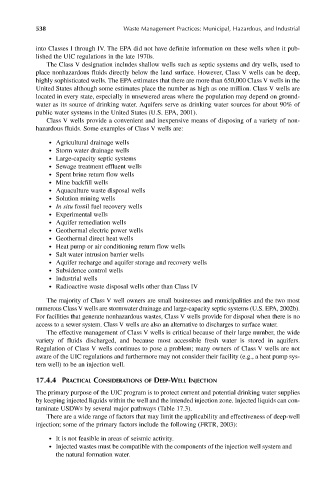Page 567 - Materials Chemistry, Second Edition
P. 567
CAT3525_C17.qxd 1/27/2005 12:44 PM Page 538
538 Waste Management Practices: Municipal, Hazardous, and Industrial
into Classes I through IV. The EPA did not have definite information on these wells when it pub-
lished the UIC regulations in the late 1970s.
The Class V designation includes shallow wells such as septic systems and dry wells, used to
place nonhazardous fluids directly below the land surface. However, Class V wells can be deep,
highly sophisticated wells. The EPA estimates that there are more than 650,000 Class V wells in the
United States although some estimates place the number as high as one million. Class V wells are
located in every state, especially in unsewered areas where the population may depend on ground-
water as its source of drinking water. Aquifers serve as drinking water sources for about 90% of
public water systems in the United States (U.S. EPA, 2001).
Class V wells provide a convenient and inexpensive means of disposing of a variety of non-
hazardous fluids. Some examples of Class V wells are:
● Agricultural drainage wells
● Storm water drainage wells
● Large-capacity septic systems
● Sewage treatment effluent wells
● Spent brine return flow wells
● Mine backfill wells
● Aquaculture waste disposal wells
● Solution mining wells
● In situ fossil fuel recovery wells
● Experimental wells
● Aquifer remediation wells
● Geothermal electric power wells
● Geothermal direct heat wells
● Heat pump or air conditioning return flow wells
● Salt water intrusion barrier wells
● Aquifer recharge and aquifer storage and recovery wells
● Subsidence control wells
● Industrial wells
● Radioactive waste disposal wells other than Class IV
The majority of Class V well owners are small businesses and municipalities and the two most
numerous Class V wells are stormwater drainage and large-capacity septic systems (U.S. EPA, 2002b).
For facilities that generate nonhazardous wastes, Class V wells provide for disposal when there is no
access to a sewer system. Class V wells are also an alternative to discharges to surface water.
The effective management of Class V wells is critical because of their large number, the wide
variety of fluids discharged, and because most accessible fresh water is stored in aquifers.
Regulation of Class V wells continues to pose a problem; many owners of Class V wells are not
aware of the UIC regulations and furthermore may not consider their facility (e.g., a heat pump sys-
tem well) to be an injection well.
17.4.4 PRACTICAL CONSIDERATIONS OF DEEP-WELL INJECTION
The primary purpose of the UIC program is to protect current and potential drinking water supplies
by keeping injected liquids within the well and the intended injection zone. Injected liquids can con-
taminate USDWs by several major pathways (Table 17.3).
There are a wide range of factors that may limit the applicability and effectiveness of deep-well
injection; some of the primary factors include the following (FRTR, 2003):
● It is not feasible in areas of seismic activity.
● Injected wastes must be compatible with the components of the injection well system and
the natural formation water.

